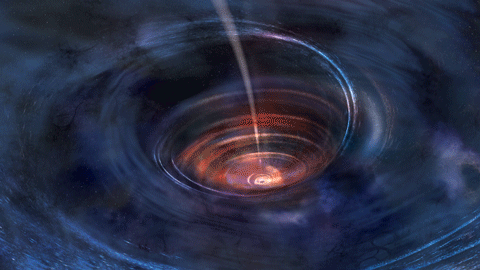Using a technique akin to echolocation, scientists were able to map the region around a distant black hole’s event horizon in unprecedented detail.
Source: National Geographic
In an enormous effort that stunned the world, scientists last year unveiled the first direct picture of a black hole, allowing humans to see what exists at the cusp of the monster’s maw. Now, astronomers have used a different technique involving x-ray “echoes” to peer even closer at one of these gravitational behemoths.
The black hole coming into focus is parked in the middle of a galaxy called IRAS 13224-3809, which sits about a billion light-years away. The supermassive object is surrounded by a swirling disk of million-degree matter and is sheathed by an x-ray corona with a temperature exceeding a billion degrees. By charting how those x-rays behave, scientists created an extremely detailed map of the region around the black hole’s event horizon, the zone beyond which not even light can escape.
Black Holes 101
At the center of our galaxy, a supermassive black hole churns. Learn about the types of black holes, how they form, and how scientists discovered these invisible, yet extraordinary objects in our universe.
“Black holes don’t give off any light themselves, so the only way we can study this is by watching what matter does as it falls onto it,” says the University of Cambridge’s William Alston, whose team reports the observations today in the journal Nature Astronomy.
It’s a much more precise measurement than even the Event Horizon Telescope, which produced last year’s black hole picture, could make for an object so far away. The new measurements of IRAS 13224-3809’s black hole helped scientists pin down its mass and spin, properties that can reveal vital clues about the black hole’s evolution. If similar measurements can be made for a larger population of nearby supermassive black holes, they could help scientists learn more about how galaxies grow.
“Understanding the spin distribution of black holes in many galaxies tells us about how we go from the early universe to the population we see today,” Alston says.
Echo mapping
Despite the innocuous name, IRAS 13224-3809 is one of the most exciting galaxies in the x-ray sky: It is an active galaxy, meaning that its innermost region shines more brightly than can be explained by stars alone, and its x-ray brightness fluctuates by a factor of 50, sometimes over just a few hours. Alston and his colleagues chose to study this particular galaxy because they wanted a dynamic, fluctuating source that could help them nail down specific properties of the central supermassive black hole.
To do that, Alston and his colleagues studied IRAS 13224-3809 using the European Space Agency’s XMM-Newton spacecraft. An Earth-orbiting telescope that studies the cosmos in x-rays, XMM-Newton stared at the distant galaxy over the course of 16 orbits—totaling more than 550 hours—between 2011 and 2016.
From those many hours’ worth of data, Alston and his colleagues assembled a map of the supermassive black hole’s x-ray corona and its accretion disk, a ring of swirling matter that’s just outside the event horizon. Some of the emitted x-rays head directly into the cosmos, but others slam into the accretion disk and take a little longer to exit the bruiser’s immediate environment.
“This extra path length causes a time delay between the x-rays that were produced originally in the corona,” Alston explains. “We can measure the echo—this time delay—which we call a reverberation.”
This technique, called reverberation mapping, helped the scientists probe the gassy material around the black hole. Alston compares the process to echolocation, in which animals such as bats bounce sound off objects to help them navigate in flight. And, unlike the process used by the Event Horizon Telescope to assemble an image of a nearby black hole, reverberation mapping can be used to study objects that are far, far away and probe regions even closer to the event horizon.
“Reverberation mapping doesn’t rely on spatial resolution at all,” says Georgia State University’s Misty Bentz, who uses the same technique to study distant black holes. “Instead, it uses light echoes within the object to tell us about structures, even very small and very far away ones.”
Staggering spin
The light echoes captured from IRAS 13224-3809 allowed Alston and his team to determine the precise geometry of the material surrounding the black hole, including the dimensions of its dynamic x-ray corona, which powers those echoes. The team could then use that information to calculate the black hole’s mass and spin, two properties that do not fluctuate on human timescales.
“To measure the mass and spin of the black hole, we need to know exactly where this gas is before it falls into the black hole,” Alston says. Scientists have used this technique to study supermassive black holes before, but those observations were neither as lengthy, nor the source as variable, as they are for IRAS 13224-3809.
Based on the new mapping, the team concluded that this supermassive black hole contains as much mass as two million suns, and that it is spinning nearly as fast as it possibly can without breaking the laws of physics. Bentz, who was not involved in the work, says the authors’ extensive observations make the results extremely convincing.
“The authors carried out the same experiment 16 times, which is significantly more than any previous studies,” Bentz says. “That really helped them to pin down the pieces that were not changing.”
Alston and his team also assembled a dynamic image of how the x-ray corona swaddling the black hole changes over time, with its size varying somewhat dramatically over a day.
Galactic seeds
Every large galaxy in the universe is likely anchored to a central supermassive black hole. Deciphering the ways in which those anchors pirouette could offer clues to how they, and their host galaxies, formed and evolved over the age of the universe.
“One of the things we don’t know is how supermassive black holes form,” Alston says. “What are the seeds of these in the early universe? Most of our models currently predict seeds that are too small, and they can’t actually grow quick enough.”
One way in which galaxies could form involves multiple small galaxies colliding and merging. As these galaxies merge, so do their central black holes. If those collisions are chaotic, they could not only contribute to the resulting bigger black hole’s mass, but also to the way it spins, Alston says.
Another way in which black holes might bulk up is through a continual stream of inflowing gas. In that case, the resulting spin might be speedier, as IRAS 13224-3809’s spin appears to be, though Alston says it’s too soon to conclude that this particular galaxy accreted mass through this mechanism.
Eventually, he and his colleagues would like to use reverberation mapping to pin down the spins—and thus the formation histories—of hundreds of nearby supermassive black holes, in effect taking a census of these objects. Then, based on how far away those black holes are, scientists can look at how galaxies grew across the age of the universe.
Source: National Geographic

































Leave a Comment
You must be logged in to post a comment.